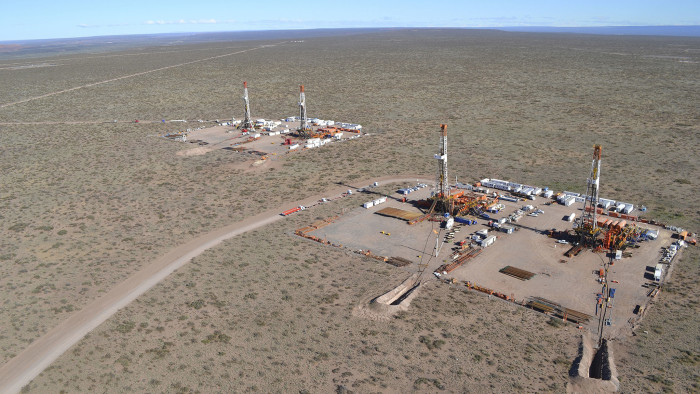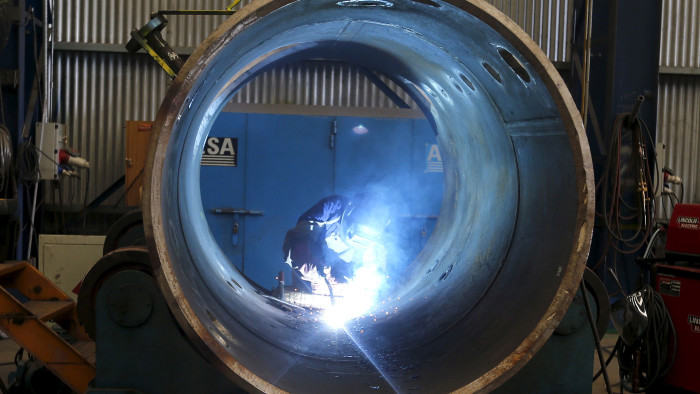Argentina looks to tap into its vast reserves of resources and energy potential

Roula Khalaf, Editor of the FT, selects her favourite stories in this weekly newsletter.
About 1,000km south-west of Buenos Aires, a drill rig towers over a low plateau of Patagonian scrubland. Inside a cabin nearby, engineers working for YPF, Argentina’s state-controlled oil company, use a computer screen to monitor the steady advance of the drill: it has so far bored some 3,300 metres into what the company hopes is some of the best rock on earth.
This is the latest so-called “unconventional” oil well being sunk in the Loma Campana field — a joint venture between YPF and Chevron, the US oil producer. Loma Campana taps the resources of the Vaca Muerta formation — a layer of shale bearing oil and gas that can be liberated by fracking, just as similar resources in Texas and elsewhere have transformed the US’s energy supply.
Will such shale resources do the same for Argentina? Hopes are high: Vaca Muerta — which covers 30,000 sq km and is hundreds of metres thick — is one of the assets that put Argentina among the countries best endowed with shale oil and gas, according to the US Energy Information Administration.
“In terms of productivity Vaca Muerta compares very favourably. If you look at current well results there, the best are in line with the top shale plays in the US,” says Horacio Cuenca, research director for Latin America at industry analysts Wood Mackenzie.
Development of the fields here will play a key part in solving one of Argentina’s great conundrums: the disparity between its huge energy potential and its rickety energy supply. This potential is based not just on reserves of hydrocarbons such as Vaca Muerta, where companies such as Dow Chemical, Exxon and Total are also among the investors. Argentina is also ideally placed to generate renewable energy, across sparsely populated regions from sun-baked deserts to windswept Patagonia.
Yet as a producer Argentina languishes, having gone from being a net exporter to today relying on imported gas and diesel to keep the lights on. Generating capacity, like the current account deficit, is under strain.
Juan José Aranguren, a former head of Shell in Argentina appointed as energy minister by president Mauricio Macri, lays much of the blame at the door of the previous government for distorting the energy market with subsidised domestic energy prices, boosting demand while creating a disincentive to supply.
The tariff structure for domestic energy that Macri’s government inherited was only covering about 10 per cent of generating costs, Aranguren says. “Argentina got used to basically having energy that was next to free.” But his attempts to change the situation have already brought severe protests that show the size of the task confronting the government. Vocal opposition to his tarifazo — his attempt to raise domestic energy prices by several hundred per cent — are already showing that energy is an important battleground for the government if its reform agenda is to be cemented and implemented.
Daniel Montamat, a former energy minister and analyst, identifies two priorities for Argentina. First, to increase domestic natural gas supply to fill the gap being plugged by imports from Bolivia and Chile as well as by liquefied natural gas. Second, to diversify the country’s sources of electricity generation away from reliance on fossil fuels — something Macri’s government is starting to do with a programme to raise the tiny share of power generated from renewable sources.

Another analyst, Francisco Mezzadri, reckons it will take until 2030 to restore to Argentina’s power generating capacity a comfortable reserve margin to cope with sporadic peaks in power use or maintenance outages. The necessary investment could amount to $4.5bn annually, he says.
This year the government has awarded 2,900MW in thermal generation contracts and in recent months has also tendered for at least 1,000MW of renewable energy supply, in a bid to start expanding and renewing generating capacity.
Yet if Argentina’s return to financial markets gives more grounds for optimism that the country can attract investment to its energy sector, the currently depressed global prices of oil and gas present strong headwinds.
Argentina has endeavoured to shelter the industry from some of the downturn, maintaining a minimum domestic price for oil and gas that is higher than the international market price. Aranguren says this measure has also safeguarded jobs and revenues in many provinces.
But in the long term only a continued drive to improve the competitiveness of the country’s oil and gas resources will have the desired effect — and a key part will be played by the drill rigs of the Vaca Muerta fields. “Shale is the future of hydrocarbons in Argentina,” says Daniel González, chief financial officer of YPF.
Ernesto López Anadón, president of the Argentine Institute of Oil and Gas (IAPG), cites three advantages for Argentina in shale in Vaca Muerta: the quality and quantity of the resource; the basin’s sparse population, allied with plenty of the water resources that fracking needs; and the fact that the basin has been part of Argentina’s conventional oil and gas fields for decades, so has plenty of necessary infrastructure.
In Neuquén, the regional capital that is a hub for operations in the Vaca Muerta, Pablo Bizzotto, the regional head of YPF’s unconventionals business, says rapid improvements in drilling methods and local availability of key supplies such as sand, are helping to cut costs and raise returns. “We are half a year ahead of where we wanted to be,” he says. “We want everything that is good in Loma Campana to happen in other fields too. We need to keep the learning curve as short as possible.”

Measured against these improvements are complaints from many in the industry about Argentina’s disadvantages. These include inadequate road infrastructure and high labour costs: drill crews, protected by strong trade unions, typically have more workers than in the US and generously paid travel and rest time. Meanwhile, wind speeds that would not halt work in Texas do so in Argentina.
Much will depend on YPF, which was taken out of the majority control of Spanish group Repsol under Argentina’s previous government in 2012. The company has been under new leadership since Miguel Galuccio, its internationally respected chief executive, quit amid signs that he did not see eye to eye with Aranguren.
Wood Mackenzie’s Cuenca says YPF “is sitting on a lot of the best acreage” in Vaca Muerta. “But how much capacity does the company have to develop them? They only have so many resources and so many people — it means a slower overall ramp-up of shale production for Argentina,” he says.
Montamat says Argentina needs fewer advantages for incumbent producers — and more of the sort of small nimble companies that helped to propel shale development in the US. “We need many more players — more competition and more innovation,” he says.

Marcelo Álvarez, president of the country’s renewable energy chamber, says Argentina is still a “microscopic” market compared with its potential — behind even countries such as Guatemala and Panama in its use of renewables.
The government’s target is that renewables should provide 8 per cent of power by 2018 and 20 per cent by 2025. Sebastián Kind, the government’s under-secretary for renewable energy, says the government now “has the tools” to make this happen, including a series of guarantees — including one from the World Bank — to make sure that contracts awarded to providers of renewable energy will be honoured.
Ultimately, says Kind, the cost of capital is decisive in making sure that renewable energy providers can be competitive — and the guarantees to bidders in the programme are a way to mitigate the Argentine country risk that has held back development.
“We have to provide an extra step to give confidence in the programme,” he says. “This is three levels of warranties — a full set.”
Asked whether renewables providers can be competitive, Kind has a simple answer that sums up the urgency of Argentina’s desire to leave behind its current energy scarcity. “The most expensive power,” he says, “is that which we don’t have.”
Rocky patch: ‘Everything to play for’
Alongside agriculture and the extraction of oil and gas, mining is Argentina’s third great primary industry but is a considerably weaker pillar. Nor is it anywhere near as important as in neighbouring countries such as Chile, in spite of obvious similarities in geology that have led to some attempts at cross-border mining projects high in the Andes.
International companies, including Glencore, Goldcorp and AngloGold Ashanti, are mining successfully for minerals, from lithium in sun-baked northern salt pans to gold in Patagonia. But much of Argentina remains unexplored.
Daniel Meilán, the country’s mining secretary, says that of the 750,000 sq km of the country that might reasonably be expected to contain worthwhile mineral deposits, less than 25 per cent has been awarded in concessions, and of those more than 90 per cent are still at early-stage exploration, with less than 4 per cent hosting operating mines. “There is everything to play for,” says Meilán.
Even without Argentina’s recent economic turbulence, and the downturn in much of the mining sector, there are plenty of obstacles. At least seven provinces — which own rights over minerals — have placed some sort of curbs on the industry, out of concern over the potential impact on the environment.
Meilán says he wants to establish much more coherence and consensus over mining policy. He also plans to set up a fund, paid for by a levy on exports, to help build support for mining in areas where projects are operating or about to start.
“The biggest challenge for mining in Argentina is to recover society’s trust,” says Marcelo Álvarez, country manager for Goldcorp and since last year the head of Argentina’s mining chamber. However, an accident at Veladero, a Barrick Gold mine, that released a cyanide solution into a river last year can scarcely have helped public confidence.
Álvarez says there is $20bn of planned investment in the sector, from exploration to construction, but in spite of the recent government support, many of the projects are likely to be on hold until global sentiment over commodities improves. Another executive says: “It would be naïve to think that after six months of nice messages the pipeline would start up like a factory and we would be delivering mines as if we were producing cupcakes — the industry does not work like that.”
Argentina’s resources in precious metals and lithium — the object of an excited scramble because of demand to make batteries for electric cars — probably have the best short-term prospects.
One recent investor is Canada-listed Fortuna Silver, which in July acquired Goldrock, owner of the Lindero gold project in Salta province. Jorge Ganoza, Fortuna’s chief executive, said the company had first looked at Lindero and Goldrock in 2010 but had not proceeded because of the political situation in Argentina at the time. Under the Macri government, “we have seen what we want to see”, Ganoza says. Fortuna hopes to start mining in 2018.
Meilán acknowledges that patience will be required for all of the promised investment by other companies. “I am trying to get everything in order,” he says, “so that when the train comes past we are all waiting in the station, ready to board.”
Comments